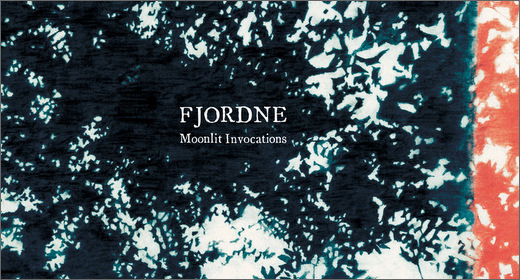Moonlit Invocations is modernist art, a Cubist canvas on a cocktail napkin.
Fjordne (Fujimoto Shunichiro, also known as “FjS”) first came to my attention with The Setting Sun in its magnificent art edition designed by musician/graphic artist April Lee, a recording about “listening to touching,” as I wrote, of strings and piano keys, music that “wants to be heard without headphones, out of proper stereo speakers, because the music wants to touch, too, it wants to touch wooden floors and furniture and bump into walls.” Musically and visually, The Setting Sun was an evocation of “an old world patinated by loving overuse.”
Six years on and the artist is still warmheartedly integrating acoustic and digital sources and his fingers continue to grasp at the past. Moonlit Invocations deconstructs piano jazz coolth, chopping it up, screwing and glitching it, as a reimagining of the world slipping into the postwar, atomic era, while also blurring lines of precise chronology—it could be any time from the late forties to the early sixties, perhaps even is, all at once. Place is also undeterminable—piano bar, hotel lounge, dance palace ballroom—though either way, places of encounter, where people may or may not have your best interests at heart and the music is ostensibly incidental.
“Sound texture” and “twisted time” comprise Fjordne’s personal space-time continuum, fragmenting flatlands into more plentiful, estuarine landscapes. To him, abstraction is order, a derangement of arrangement to make it more intelligible, most subtly achieved on the closing “Behind Exquisite, Tragic.” As a listener, I was genuinely uncertain whether he was at the keyboard himself or sampling period recordings, though the notes claim the latter and vinyl does indeed occasionally crackle. Not strictly solo, it is variously backed up by drum kit, often brushed, saxophone, some magnificently massed and looped background singers, a small string section. Some field recording and movie dialogue are judiciously patched in.
Throughout, however, the piano is centerstage, played beautifully, long unmolested, descending like the spray off a waterfall on “Rejoice Moon.” But like Margaret Dumont in all her stately but unworldly gravity, Fjordne is all three Marx Brothers sallying against her—he makes the instrument more intelligible. He rends “Rejoice Moon” in two with a searing guitar and box-kicking percussion. He wanders champagne drunk into the “Autumn Wind.” Incongruous hand-clapping along to a number with a bit of exotica sway (“Reverends”) confuses the band. On “Coenbiac,” he errs wisely on the side of overload. Thus (re)sensated, this mood music is endowed with a new, more physical presence. Moonlit Invocations is modernist art, a Cubist canvas on a cocktail napkin.
Moonlit Invocations is available on White Paddy Mountain.



















![Romanowitch :: A critical season substitute (glitch.cool) — [concise]](https://igloomag.com/wp/wp-content/uploads/2025/03/romanowitch-a-critical-season-substitute_tape_feat-75x75.jpg)








